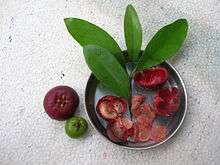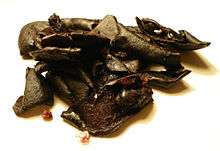Garcinia indica
Garcinia indica, a plant in the mangosteen family (Clusiaceae), commonly known as kokum, is a fruit-bearing tree that has culinary, pharmaceutical, and industrial uses.
| Garcinia indica | |
|---|---|
 | |
| Kokum fruits, seeds, pulp and rinds | |
| Scientific classification | |
| Kingdom: | Plantae |
| Clade: | Tracheophytes |
| Clade: | Angiosperms |
| Clade: | Eudicots |
| Clade: | Rosids |
| Order: | Malpighiales |
| Family: | Clusiaceae |
| Genus: | Garcinia |
| Species: | G. indica |
| Binomial name | |
| Garcinia indica | |
Taxonomy

The genus Garcinia, belonging to the family Clusiaceae, includes about 200 species found in the Old World tropics, mostly in Asia and Africa. Garcinia indica is an evergreen, monoecious tree.[2] The tree can grow as high as 18 meters.On maturity the trees attain a pyramid shape. The fruit is an orange size purple color berry with fleshy endocarp.[3][4] The fruit of the plant contain five to eight large seeds which account for 20-23% of the fruit's weight. The kernels account for 61 percent of the weight of the seed, while the oil content of the kernel accounts for about 44%. The seeds are compressed and embedded in an acidic pulp.
Distribution
Garcinia indica is indigenous to the Western Ghats region of India located along the western coast of the country. Of the 35 species found in India, 17 are endemic. Of these, seven are endemic to the Western Ghats, six in the Andaman and Nicobar Islands and four in the northeastern region of India. The kokum variety from the Ratnagiri and Sindhudurg districts from the coastal Konkan region of the state of Maharashtra in India has received the GI (Geographical Indication) tag.
Garcinia indica is found in forest lands, riversides and wastelands. These plants prefer evergreen forests, but sometimes they also thrive in areas with relatively low rainfall. It is also cultivated on a small scale. It does not require irrigation, spraying of pesticides or fertilizers.
Uses
Culinary uses

The outer cover of fruit is dried in the sun to get aamsul or kokam.[5] It is used as a souring agent typically in Maharashtrian cuisine, Goan cuisine, and in some parts of Karnataka. Kokum yields a peculiar flavour and deep-red colour. As a souring agent, it is used as an alternative to tamarind in curries and other dishes from south India.[4] It is also used in cuisine from Gujarat, where it is frequently used to add flavor and tartness to dal (lentil soup) for flavor balance. It is extensively used in Assamese cuisine in many dishes like masor tenga (sour fish curry) and tenga dali (sour dal).

The fresh fruit is preserved with sugar to make bright-red squash that is diluted with water and bottled for sale as a beverage.
The extract of the fruit is called aagul in Konkani and Marathi. It is added during the preparation of solkadhi, which may also include coconut milk, coriander and garlic.
Industrial uses
The seed of Garcinia indica contains 23–26% Kokum butter, which remains solid at room temperature. It is used in the preparation of chocolate and sugar confectionery.[6]
Medicinal and cosmetics applications
The oily extract called Kukum butter is used in ointments and suppositories.[4] It has application in skin and hair products, acne products and skin tonics.[7]
The rind of the fruit is a good source of hydroxycitric acid which has been claimed to modify lipid metabolism.[4]
Other uses
The tree is ornamental, with a dense canopy of green leaves and red-tinged, tender, young leaves.
References
- Ved, D.; Saha, D.; Ravikumar, K.; Haridasan, K. (2015). "Garcinia indica". IUCN Red List of Threatened Species. 2015: e.T50126592A50131340. doi:10.2305/IUCN.UK.2015-2.RLTS.T50126592A50131340.en.
- "An article in the Resonance Magazine".
- Asinelli, M.E.C.; Souza, M.C.o.d.; Mourao, K.t.S.M. (2011). "Fruit ontogeny of Garcinia gardneriana (Planch. & Triana) Zappi (Clusiaceae)". Acta Botanica Brasilica. 25 (43–52).
- K. V. Peter (Editor); V.K. Raju (author); M. Reni (author) (17 August 2001). Handbook of Herbs and Spices. Elsevier. pp. 207–213. ISBN 978-1-85573-645-0.CS1 maint: extra text: authors list (link)
- Ron Herbst; Sharon Tyler Herbst (2015). The Deluxe Food Lover's Companion, 2nd edition. Barron's Educational Series. ISBN 978-1-4380-7621-8.
- Kanes K. Rajah (2002). Fats in Food Technology. CRC Press. p. 167. ISBN 978-0-8493-9784-4.
- Mohammad Atha, Syed Mahmood Nasir,Taxonomic perspective of plant species yielding vegetable oils used in cosmetics and skin care products, African Journal of Biotechnology Vol. 4 (1), pp. 36-44, January 2005 ISSN 1684-5315 © 2004 Academic Journals
